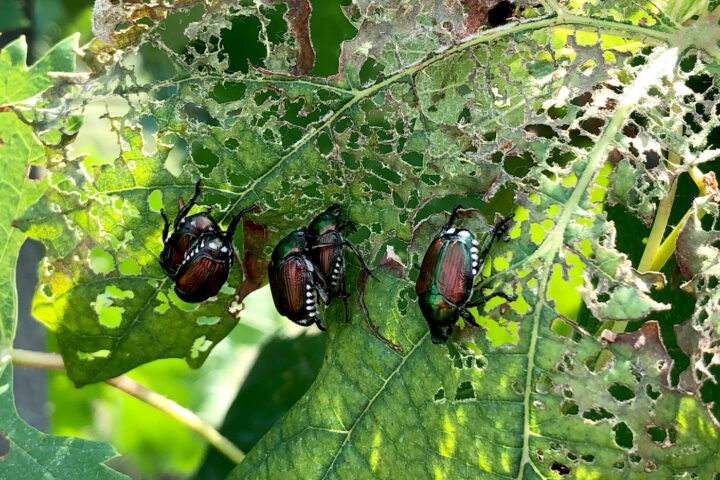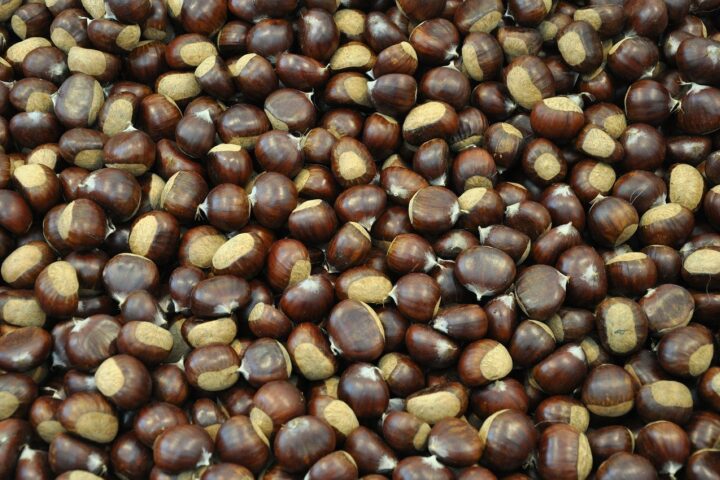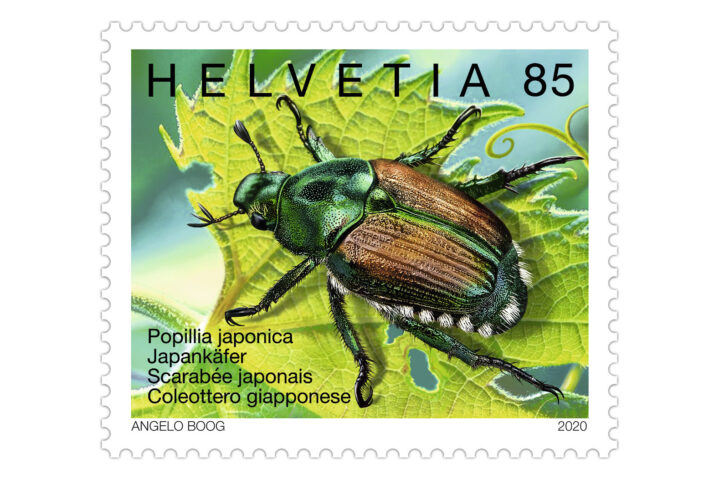
Invasive pests travel with us
Invasive pests and plant diseases are among the greatest challenges for biodiversity and agriculture. They often enter Switzerland via travel and imported goods and cause great damage to cultivated and wild plants. Since 2020, the import of plants from non-EU countries is prohibited. However, introduced pests are a worldwide problem.
Wednesday, August 9, 2023
In brief:
- Invasive pests are spreading more and more through the international movement of people and goods.
- They are displacing native fauna and flora in new areas and sometimes causing massive damage to agriculture.
- To counteract this danger, research- and innovation-friendly framework conditions are needed.
Megatrend: Globalization
After the Corona relaxations, many people are once again longing for vacations abroad. However, those who travel also have a responsibility for domestic plant health. Plants from exotic areas should not be taken home. There is a risk that they may be infested with diseases or pests that could spread here. Since January 1, 2020, it has been prohibited to import plants, fruits, vegetables, cut flowers or seeds from non-EU countries into Switzerland. Exceptions are pineapples, bananas, dates, durian and coconuts. Switzerland has harmonized its phytosanitary regulations with the EU. The measure shows: Native plant life is threatened. Many invasive pests have already spread.
No natural enemies
Take the Japanese beetle, for example. It originated in Japan and arrived in North America a good 100 years ago. In 2014, it was discovered for the first time on the European mainland near Milan. In the summer of 2023, a larger population of Japanese beetles was discovered for the first time north of the Alps in Kloten. The authorities acted immediately and used insecticides to control the beetle. The aim was to prevent it from spreading to other areas. This could have devastating consequences for agriculture. The beetle attacks trees (e.g. apple, elm, linden, maple, peach), shrubs (e.g. grapevine, blackberry, rose) and other plants (e.g. corn, soybean). It sometimes eats the plants bare except for the twigs and leaf skeletons. The Japanese beetle has no natural enemies in Switzerland and is extremely difficult to control.
How is the Japanese beetle controlled?
In controlling the Japanese beetle, the authorities depend on the help of the population. Sightings of the beetle are to be reported immediately to the responsible authorities. It is then controlled by setting traps, banning watering and applying highly effective pesticides. The insecticides used by the authorities in Kloten were approved for a limited period by emergency permit. This pragmatism is correct, because at present the Japanese beetle can be controlled most effectively with plant protection products.
Danger for chestnuts
Another example is the so-called sweet chestnut gall wasp. It also originates from Asia and endangers native plants. It was first sighted in northern Italy in 2002 and made the leap across the border into Ticino in 2009. In the meantime, practically all chestnut forests in Ticino are infested. The females of the sweet chestnut gall wasp lay their eggs in the twig and flower buds of chestnut trees. This results in conspicuous galls on the shoots, leaves and flowers. Although the trees rarely die, they are weakened by the infestation and more susceptible to disease. The chestnut harvest is drastically reduced.
Major damage in fruit growing
The marmorated tree bug, also known as the stink bug, was introduced from Asia and is causing great concern, especially in fruit growing. The canton of Thurgau is particularly badly affected. Last year, around 25 percent of pears were lost there due to the bug. The stink bug leaves punctures in the pears that lead to dents and deformations. Control is proving difficult. Effective chemical agents are not approved in Switzerland. The samurai wasp is a natural enemy of the stink bug and could be used in Switzerland to control the tree bug. However, before it can be released into the wild, several years of testing are required. This is to ensure that the wasp does not pose a threat to native animals.
Asian hornet
The Asian hornet, on the other hand, poses a threat to native bees. It has spread strongly in Switzerland in the past year. The problem is that it preys on honeybees.
Do not hinder research
The issue is not only present in Switzerland, but all over the world. Plants are essential for biodiversity and life. They produce oxygen and provide food for the vast majority of living creatures. Around 80 percent of the food consumed by humans is of plant origin. Invasive pests threaten wild and cultivated plants worldwide. This affects the food security of millions of people. To ensure sufficient food for the world's growing population in the future, farmers depend on the use of crop protection products. However, there are still no suitable means of combating various diseases and pests. That is why research is needed - also in Switzerland. Against this backdrop, it seems absurd that political initiatives repeatedly want to ban the production and use of pesticides in Switzerland altogether. A ban would not only prevent the use of pesticides against invasive pests, but would also make the further development of pesticides impossible.
Sources
Neue Zürcher Zeitung, July 27, 2023
Neue Zürcher Zeitung, July 25, 2023
Federal Office for Agriculture FOAG: International Year of Plant Health
Kindly note:
We, a non-native editorial team value clear and faultless communication. At times we have to prioritize speed over perfection, utilizing tools, that are still learning.
We are deepL sorry for any observed stylistic or spelling errors.
Related articles

Report the invasive Japanese beetle immediately!
The voracious Japanese beetle is threatening to spread in Switzerland. It was introduced to Switzerland four years ago and was first discovered in the canton of Ticino. To prevent the spread of the pest, the Agroscope research centre is working together with the people of Ticino. An innovative tool is being used to enable the rapid reporting of any discoveries of the Japanese beetle.

Invasive species threaten native plants
The economic interdependence of the world has increased greatly over the past years and decades. Due to the brisk trade activity between the continents, invasive plant and animal species are also spreading faster and faster. This can lead to serious problems for native vegetation and agriculture. According to the FOEN, the canton of Ticino is particularly affected.

Traveling Japanese beetle threatens native plants
The Japanese beetle was first discovered in Switzerland in 2017 in Ticino. Now it has made it to the northern side of the Alps. After being found in Basel-Stadt and Solothurn, a larger population of the beetles has been found in Kloten for the first time. They are controlled with traps, but also pesticides.

Residues, thresholds, trust – looking calmly behind the headlines
In this conversation with toxicologist Lothar Aicher, the discussion focuses on how residues enter the body, how their potential harm is assessed, and what role modern analytical methods play.

Hazard is not the same as risk: how we understand – and should understand – threshold values
In this episode of the podcast, risk researcher Angela Bearth discusses residues and threshold values in food – a topic often debated emotionally. In public discussions, threshold values tend to dominate, while the complex challenges of agriculture are rarely considered. Studies show, however, that once these relationships are explained and solutions are addressed, people respond in a more differentiated way.

PFAS, trade-offs and responsibility – how politics and agriculture find solutions
In this episode of the joint series by Agrarpolitik – der Podcast and swiss-food.ch, National Councillor Christine Badertscher discusses how residues and threshold values are debated in Parliament.

Thresholds, approvals, responsibility – how plant protection products are really assessed
Threshold values are often at the centre of public debate – yet in reality they are only a small part of a much broader risk assessment system. Dr Michael Beer, Head of the Food and Nutrition Division at the Federal Food Safety Office, provides clarity.

